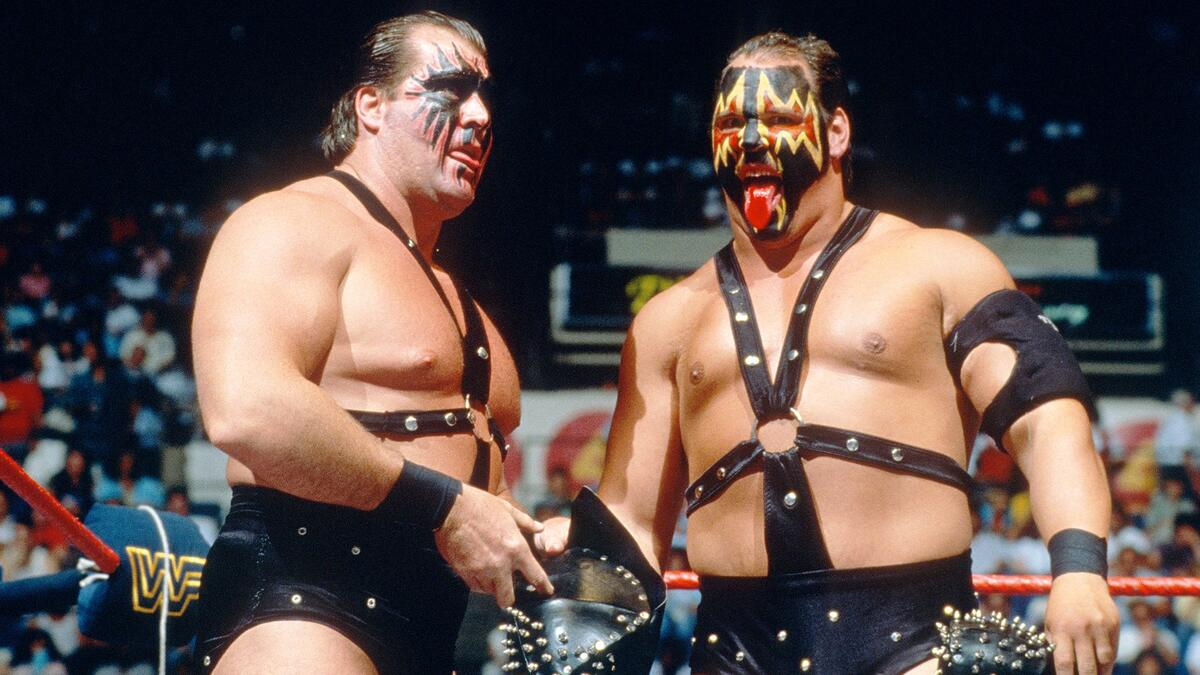Abbott and Costello in the Foreign Legion, released in 1950, has probably the funniest wrestling scene ever put into a Hollywood movie, and the movie isn’t really about wrestling at all.
The film starts out with Abdullah the Arabian Assassin (the imposing pro wrestler Wee Willie Davis) and Bertram the Magnificent (wrestler, and later announcer, Sam Menacker) practicing their moves in a wrestling gym. (Another wrestler, Tor Johnson, is in the film.) The promoter Lou Hotchiss (Lou Costello) is instructing them on their moves and gets frustrated. “Best script I ever wrote and you guys smell it up!” he laments.
To improve the scenario, he calls co-promoter Bud Jones (Bud Abbott) into the ring, and has the two behemoths demonstrate on the roly-poly funny man. Of note, there’s a great swing move — maybe WWE’s Cesaro got the idea here?
It comes to a head when Abdullah refuses to go along with the script and put his opponent over. In protest, he leaves not only the ring and the gym, but the country, returning to Algeria. As Hotchiss and Jones had borrowed $5,000 from the “syndicate” to bring in Abdullah, they feel compelled to follow across the globe to convince him to return.
From there, it’s a pretty typical Abbott and Costello movie, with hijinks, misunderstandings, pratfalls, and one-liners. The duo end up serving in the Foreign Legion and out in the desert.
“The film contains some pretty good gags, including an idiotic but entertaining wrestling match; problems with the French language, and a scene in which the pudgy Lou unwittingly buys six slave girls — the auctioneer wouldn’t break up the package,” reads a review in the Chicago Tribune.
The New York Times didn’t rave about it: “The laughs, oddly enough, are rarely abdominal. There are a few chuckles as the pair, anxious to save their hides and bring their wandering pachyderm back into the fold of the Brooklyn ‘Syndicate’ for which they work, belabor each other, wander into harems, blow up a fort and tear around the desert in a jeep.”
The 1991 book, Abbott and Costello in Hollywood, by Bob Furmanek and Ron Palumbo, offers some interesting insight to the wrestling scenes. For one, there was a section that was cut with Bud Abbott wrestling midgets, with the lines:
“What’s the idea of teaching midgets to wrestle?” Bud asks.
“They’re for those small television sets!” Lou explains.
Wee Willie Davis gets the most screen time of the wrestlers, since he appears throughout the film. Naturally, he is not “wee” at all, but was billed at an imposing 6-foot-9, 300 pounds. Davis, a native of Kentucky, started wrestling around 1935 and was a major star for many years. He parlayed his wrestling fame into a decent movie career, and appeared in the likes of Mighty Joe Young, The Asphalt Jungle and Samson and Delilah. After the film work dried up, he returned to Louisville, where he became a deputy sheriff at the county jail.
Sam Menacker was probably more famous for his voice than he ever was as a wrestler. He was the long-time announcer for Paul Bowser’s wrestling TV show, Bedlam From Boston, in the 1950s, worked for Jim Barnett in Australia, and Dick the Bruiser in Indianapolis. He was the host of Stu Hart’s Stampede Wrestling from 1960-62 and briefly again in 1984 when Ed Whalen quit the promotion in protest over the violence. In Calgary, there’s a famous story where Menacker, a trained pilot, stole a plane that belonged to Hart. “One day, he was going some place and he took off on the plane down to the United States and never came back,” recalled Bob Geigel. For a time, he was married to champion women’s wrestler June Byers.
Film censor Joseph Breen apparently didn’t appreciate some of the mayhem in the wrestling scenes, and, according to Furmanek and Palumbo, asked for changes to the script: “Furthermore, we direct your attention to a problem which has developed in this latest edition, of the story [draft dated November 16, 1949]. We refer to the business on pages 98 and 99, in which various characters jab their fingers in each other’s eyes. We consider this type of extremely dangerous to put on the screen, having in mind that it is the kind of business which is likely to incite imitation among the many youthful members of your audience. Consequently, we feel that this eye-jabbing routine is definitely inacceptable under the Code, and could not and be approved in a finished picture. Some other device will have to be invented as a substitute.” (Instead, there’s a slap across the bridge of the nose, leaving the eye-pokes to the Three Stooges.)
The film is available on Netflix (in the U.S., at least), and has also been posted on YouTube by a channel called Curated Movies & TV Shows.




